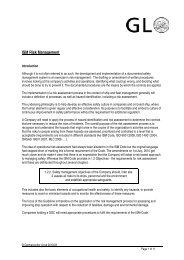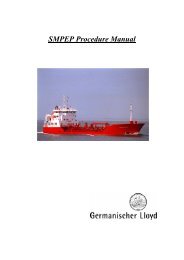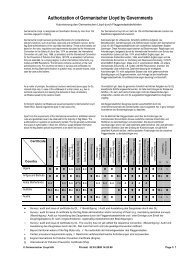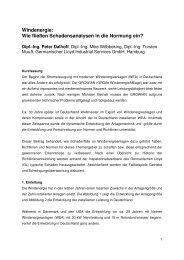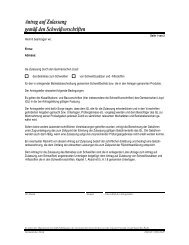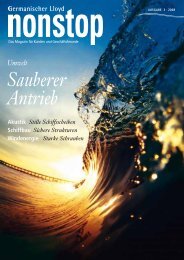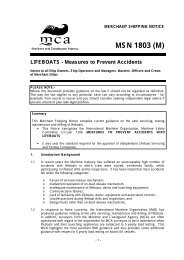Yards Moving Forward - GL Group
Yards Moving Forward - GL Group
Yards Moving Forward - GL Group
Create successful ePaper yourself
Turn your PDF publications into a flip-book with our unique Google optimized e-Paper software.
the turnover on average. Together with innovations and improvements<br />
in productivity, cost reductions are amongst the<br />
perennial topics. To cut costs, the companies are now making<br />
every effort to advance the international distribution of labour.<br />
The towing of ship sections or entire hull bodies from<br />
Eastern Europe by tug for final assembly in German yards has<br />
become a common sight in the North Sea and Baltic. Considerable<br />
savings are indeed possible by having the labour-intensive<br />
steelwork carried out in the low-wage countries of<br />
Eastern Europe. In addition, purchasing large components<br />
overseas also helps to secure new jobs in Germany.<br />
Global Distribution of Labour<br />
It was with this concept that the Lloyd Shipyard of Bremerhaven,<br />
which concentrates mainly on repairs and conversions,<br />
achieved a successful re-entry into the ship newbuilding<br />
business. The firm recently won a contract to construct<br />
two heavy-lift dock ships worth about 100 million US dollars.<br />
By having the bare hulls built in Poland, both the yard and the<br />
customer, the Bremen shipping company Harren & Partner,<br />
can be satisfied. The German Aker yards in Wismar and Warnemünde<br />
also intend to spread the work around more in future.<br />
From 2007, they plan to procure ship sections from the<br />
Ukraine (Okean Shipyard), with a view to increasing their<br />
throughput of 13 to 14 ships a year considerably. “Since the<br />
planned increase in production means we will need extra<br />
steelworking capacity in the forthcoming years, this will be<br />
the beginning of a long-term cooperation, as is already practised<br />
between other yards of the <strong>Group</strong>,” explains Matthias<br />
Trott, Press Officer of Aker <strong>Yards</strong> Germany.<br />
Naval shipbuilding in Germany has also involved crossborder<br />
cooperation for some time now. In recent times, there<br />
have been several European Community programmes, e.g.<br />
the cooperation between Germany and Italy in the construction<br />
of the submarine Class 212 or with the Netherlands for<br />
the Frigate 124 and LCF frigate. “Those were just the early<br />
beginnings. I believe that many more chapters will be written<br />
in the annals of European collaboration,” says Dr. Klaus Borgschulte,<br />
Chairman of the Executive Board at ThyssenKrupp<br />
Marine Systems (TKMS). Through its merger with HDW early<br />
in 2005 and the take-over of the electronic systems supplier<br />
Atlas Elektronik this year, the Aker <strong>Group</strong> has consolidated<br />
YARDS MOVING FORWARD<br />
the capacities for naval shipbuilding on a national level. And<br />
by integrating Swedish and Greek yards into the <strong>Group</strong>, “we<br />
already have a broad European line-up,” Borgschulte emphasizes.<br />
In the short term, however, the yard manager regards<br />
any further concentration in Europe as being problematic,<br />
because naval shipbuilding in some important countries –<br />
like France, Spain and Italy – is either excessively state-dominated<br />
or still too fragmented. “The decisive aspect is that the<br />
national consolidation should be concluded first,” says Borgschulte.<br />
An important decision for naval shipbuilding at the<br />
Emden and Hamburg locations is likely at the end of the year.<br />
It is expected that the budget committee of the German parliament<br />
(Bundestag) will pass a resolution on ordering the<br />
construction of four new Class 125 frigates from TKMS early<br />
in December.<br />
Werner Lundt, Director of<br />
the German Shipbuilding<br />
and Ocean Industries Association<br />
(VSM)<br />
Too Few Engineers<br />
“There will<br />
always be shipbuilding<br />
in Germany<br />
– in 2015<br />
and also in 2025!”<br />
A problem that is causing headaches for both naval and<br />
merchant shipbuilding is the lack of marine engineers. The<br />
demand exceeds the supply by far. Some 120 new entrants are<br />
needed every year, but the universities and the universities of<br />
applied sciences in Germany can only offer about 70 graduates<br />
in the faculties of shipbuilding and offshore technology<br />
annually. In the commercial area, the need for skilled labour<br />
fluctuates a great deal, because the order situation for the<br />
yards does not always remain constant. While one shipyard is<br />
urgently looking to hire new staff, the other does not have<br />
enough work for its existing personnel. The sad consequence<br />
is that shipbuilding specialists often change to allied<br />
branches of industry, although they may be ideally placed at<br />
another location. The know-how of these experts is then irrevocably<br />
lost to shipbuilding. For this reason, the yards have<br />
suggested that a supra-company labour pool be set up, so that<br />
they can exchange skilled personnel as needed. This will make<br />
it easier to balance out the busy and slack periods at the various<br />
sites. As is the case with many other innovations, adequate<br />
support from the government on the one hand and<br />
from the works councils and workforce on the other is paramount.<br />
“There will always be shipbuilding in Germany – in<br />
2015 and also in 2025,” VSM Director Lundt is certain. The<br />
question is just: how much will remain? If it is possible to<br />
unite the forces of industry, politics and employee representation<br />
in the shipbuilding sphere, the chances of sustained success<br />
are very good indeed. The German yards would then still<br />
be “as broadly positioned as they are today,” says Lundt, and<br />
could even “win back lost market shares.” ■ MPH<br />
nonstop 3/2006 19<br />
FOTO: MICHAEL HOLLMANN






